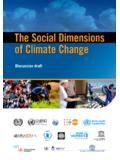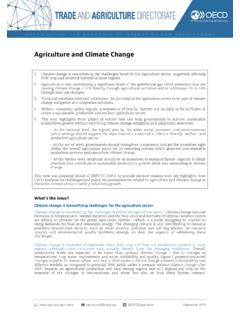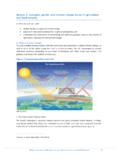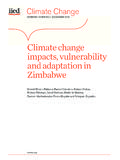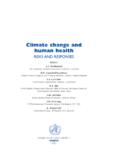Transcription of coping with CLIMATE CHANGE
1 coping with CLIMATE . CHANGE . THE ROLES OF. GENETIC RESOURCES. FOR FOOD AND AGRICULTURE. coping with CLIMATE . CHANGE . THE ROLES OF. GENETIC RESOURCES. FOR FOOD AND AGRICULTURE. FOOD AND AGRICULTURE ORGANIZATION OF THE UNITED NATIONS. ROME, 2015. RECOMMENDED CITATION. FAO. 2015. coping with CLIMATE CHANGE the roles of genetic resources for food and agriculture. Rome. The designations employed and the presentation of material in this information product do not imply the expression of any opinion whatsoever on the part of the Food and Agriculture Organization of the United Nations (FAO) concerning the legal or development status of any country, territory, city or area or of its authorities, or concerning the delimitation of its frontiers or boundaries. The mention of specific companies or products of manufacturers, whether or not these have been patented, does not imply that these have been endorsed or recommended by FAO in preference to others of a similar nature that are not mentioned.
2 The views expressed in this information product are those of the author(s) and do not necessarily reflect the views or policies of FAO. ISBN 978-92-5-108441-0 (print). E-ISBN 978-92-5-108442-7 (PDF). FAO, 2015. FAO encourages the use, reproduction and dissemination of material in this information product. Except where otherwise indicated, material may be copied, downloaded and printed for private study, research and teaching purposes, or for use in non-commercial products or services, provided that appropriate acknowledgement of FAO as the source and copyright holder is given and that FAO's endorsement of users' views, products or services is not implied in any way. All requests for translation and adaptation rights, and for resale and other commercial use rights should be made via or addressed to FAO information products are available on the FAO website ( ) and can be purchased through Contents Foreword v Acknowledgements vii Summary ix Impacts of CLIMATE CHANGE on agriculture, forestry, aquaculture and fisheries x responding to CLIMATE CHANGE genetic resources as a basis for adaptation xiii An ecosystem approach to meet the challenges of CLIMATE CHANGE xvii Introduction 1.
3 Linda Collette, Damiano Luchetti, Dafydd Pilling, Anna Asfaw and Agn s Fonteneau References 6. Plant genetic resources for food and agriculture and CLIMATE CHANGE 9. Andy Jarvis, Hari Upadhyaya, CLL Gowda, PK Aggarwal, Sam Fujisaka and Ben Anderson Effects of CLIMATE CHANGE on plant genetic resources and their management 9. Roles of plant genetic resources in coping with CLIMATE CHANGE 12. Conclusions and recommendations 18. References 20. Animal genetic resources for food and agriculture and CLIMATE CHANGE 23. Dafydd Pilling and Irene Hoffmann Effects of CLIMATE CHANGE on animal genetic resources and their management 25. Roles of animal genetic resources in coping with CLIMATE CHANGE 29. Conclusions and recommendations 34. References 37. Forest genetic resources and CLIMATE CHANGE 41. Judy Loo, Bruno Fady, Ian Dawson, Barbara Vinceti and Giulia Baldinelli Effects of CLIMATE CHANGE on forest genetic resources and their management 42.
4 Roles of forest genetic resources in coping with CLIMATE CHANGE 45. Conclusions and recommendations 49. References 52. Aquatic genetic resources for food and agriculture and CLIMATE CHANGE 55. Roger Pullin and Patrick White Effects of CLIMATE CHANGE on aquatic genetic resources and their management 57. Roles of aquatic genetic resources in coping with CLIMATE CHANGE 59. Conclusions and recommendations 63. References 66. Invertebrate genetic resources for food and agriculture and CLIMATE CHANGE 69. Matthew Cock, Jacobus C. Biesmeijer, Raymond Cannon, Philippa J. Gerard, Dave Gillespie, Juan J. Jim nez, Patrick M. Lavelle and Suresh K. Raina Effects of CLIMATE CHANGE on invertebrate genetic resources and their management 72. Roles of invertebrate genetic resources in coping with CLIMATE CHANGE 76. Conclusions and recommendations 80. References 84. Micro-organism genetic resources for food and agriculture and CLIMATE CHANGE 87. Fen Beed, Anna Benedetti, Gianluigi Cardinali, Sukumar Chakraborty, Thomas Dubois, Karen Garrett and Michael Halewood Effects of CLIMATE CHANGE on micro-organism genetic resources and their management 90.
5 Roles of micro-organism genetic resources in coping with CLIMATE CHANGE 94. Conclusions and recommendations 96. References 98. Main conclusions and opportunities 101. Linda Collette, Damiano Luchetti, Dafydd Pilling, Anna Asfaw and Agn s Fonteneau Identify, conserve and learn how to use genetic resources for food and agriculture 101. Promote an integrated and adaptive approach to the management of genetic resources for food and agriculture in ecosystems 105. References 109. Foreword Tackling CLIMATE CHANGE is central to achieving a sustainable future for the world's growing population and food security must lie at the heart of these efforts. CLIMATE CHANGE is one of the key drivers of biodiversity loss. The stressors and risks posed by CLIMATE CHANGE to the various sectors of genetic resources for food and agriculture (plants, animals, forests, aquatic resources, invertebrates and micro-organisms) are manifold. However, genetic resources for food and agriculture are also expected to play a significant role in mitigation of and adaptation to the consequences of CLIMATE CHANGE in support of efforts to achieve food security and nutrition objectives.
6 Genetic resources could contribute greatly to our efforts to cope with CLIMATE CHANGE , but in many cases the magnitude and speed of CLIMATE CHANGE will surpass our ability to identify, select, reproduce and eventually use these resources in the field. CLIMATE CHANGE is already affecting natural ecosystems and food production systems. In its Fifth Assessment Report, CLIMATE CHANGE 2014, the In- tergovernmental Panel on CLIMATE CHANGE (IPCC) considers, among other things, the vulnerability of human and natural systems, the observed impacts of CLIMATE CHANGE and the potential for adaptation. The IPCC Synthesis Report recognizes that agriculture offers unique synergies that can contribute to efforts to meet the CLIMATE CHANGE adaptation and mitigation needs of the coming decades, in support of food security goals. Decisions and actions related to the management of genetic resources for food and agriculture need to be taken in a timely manner if we want to adapt agriculture to the effects of a changing CLIMATE .
7 Future use of genetic resources for food and agriculture in CLIMATE CHANGE adaptation and mitigation depends upon ensuring that the relevant resources remain available. The Commission on Genetic Resources for Food and Agriculture of the Food and Agriculture Organization of the United Nations (FAO) provides an intergovernmen- tal forum for the discussion and development of knowledge and policies relevant to biodiversity for food and agriculture. Its work on CLIMATE CHANGE is of tremendous importance in supporting food global security and sustainable development, for present and future generations. Maria Helena Semedo Deputy Director-General, Coordinator Natural Resources Food and Agriculture Organization of the United Nations v Since its establishment, the Commission on Genetic Resources for Food and Agriculture has overseen global assessments of the state of the world's plant, animal and forest genetic resources for food and agriculture and negotiated major interna- tional instruments, including the International Treaty on Plant Genetic Resources for Food and Agriculture.
8 To explore the interactions between CLIMATE CHANGE and genetic resources for food and agriculture, the Commission has incorporated work on CLIMATE CHANGE into its Multi-Year Programme of Work and, in April 2013, adopted a Programme of Work on CLIMATE CHANGE and Genetic Resources for Food and Agriculture. To review the state of knowledge on the impact of CLIMATE CHANGE on genetic resources for food and agriculture and to discuss the potential roles of these resources in adaptation to and mitigation of CLIMATE CHANGE , the Commission requested FAO to conduct a scoping study on CLIMATE CHANGE and genetic resources for food and agriculture. Based on several thematic studies, this publication presents an overview of the complex interactions between CLIMATE CHANGE and plant, animal, forest, aquatic, invertebrate and micro-organism genetic resources. A scene-setting introductory section, providing a brief overview of the main interna- tional processes relevant to CLIMATE CHANGE , is followed by six sections dealing with the various sectors of genetic resources.
9 Each section addresses two key questions: 1) What are the possible effects of CLIMATE CHANGE on genetic resources for food and agriculture and how does it influence their management? 2) What are the specific roles of genetic resources for food and agriculture in coping with CLIMATE CHANGE ? The book ends with a discussion of the main conclusions and opportuni- ties identified. This publication aims to raise awareness of the important roles of genetic resources for food and agriculture in coping with CLIMATE CHANGE and to contribute to the mainstreaming of genetic resources for food and agriculture into CLIMATE CHANGE adaptation and mitigation planning at national and international levels. Linda Collette Secretary of the FAO Commission on Genetic Resources for Food and Agriculture vi Acknowledgements The sections in this book on plant, animal, forest, aquatic, invertebrate and micro- organism genetic resources were adapted by Dafydd Pilling from thematic studies produced for the FAO Commission on Genetic Resources for Food and Agriculture.
10 He is thanked for his work. Overall leadership was provided by Linda Collette. FAO staff and expert individuals including Devin Bartley, Ehsan Dulloo, Kakoli Ghosh, Mathias Halwart, Kathrin Hett, Alexandre Meybeck, Albert Nikiema, Hope Shand, Oudara Souvannavong and Kim-Anh Tempelman who provided comments and inputs during the preparation of this book are gratefully acknowledged. vii FAO/Giulio Napolitano viii coping with CLIMATE CHANGE THE ROLES OF GENETIC RESOURCES FOR FOOD AND AGRICULTURE. Summary Genetic resources for food and agriculture play a crucial role in food security, nutrition and livelihoods and in the provision of environmental services. They are key components of sustainability, resilience and adaptability in production systems. They underpin the ability of crops, livestock, aquatic organisms and forest trees to withstand a range of harsh conditions. Thanks to their genetic diversity plants, animals and micro-organisms adapt and survive when their environments CHANGE .











